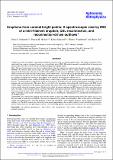Eruptions from coronal bright points : a spectroscopic view by IRIS of a mini-filament eruption, QSL reconnection, and reconnection-driven outflows
Abstract
Context. Our study investigates a mini-filament eruption associated with cancelling magnetic fluxes. The eruption originates from a small-scale loop complex commonly known as a coronal bright point (CBP). The event is uniquely recorded in both the imaging and spectroscopic data taken with the Interface Region Imaging Spectrograph (IRIS). Aims. The investigation aims to gain a better understanding of the physical processes driving these ubiquitous small-scale eruptions. Methods. We analysed IRIS spectroscopic and slit-jaw imaging observations as well as images taken in the extreme-ultraviolet channels of the Atmospheric Imaging Assembly (AIA) and line-of-sight magnetic-field data from the Helioseismic Magnetic Imager (HMI) on board the Solar Dynamics Observatory. As the observations can only indicate the possible physical processes at play, we also employed a non-linear force-free field (NLFFF) relaxation approach based on the HMI magnetogram time series. This allowed us to further investigate the evolution of the magnetic-field structures involved in the eruption process. Results. We identified a strong small-scale brightening as a micro-flare in a CBP, recorded in emission from chromospheric to flaring plasmas. The mini-eruption is manifested via the ejection of hot (CBP loops) and cool (mini-filament) plasma recorded in both the imaging and spectroscopic data. The micro-flare is preceded by the appearance of an elongated bright feature in the IRIS slit-jaw 1400 Å images, located above the polarity inversion line. The micro-flare starts with an IRIS pixel size brightening and propagates bi-directionally along the elongated feature. We detected, in both the spectral and imaging IRIS data and AIA data, strong flows along and at the edges of the elongated feature; we believe that these represent reconnection outflows. Both edges of the elongated feature that wrap around the edges of the erupting MF evolve into a J-type shape, creating a sigmoid appearance. A quasi-separatrix layer (QSL) is identified in the vicinity of the polarity inversion line by computing the squashing factor, Q, in different horizontal planes of the NLFFF model. Conclusions. This CBP spectro-imaging study provides further evidence that CBPs represent downscaled active regions and, as such, they may make a significant contribution to the mass and energy balance of the solar atmosphere. They are the sources of all range of typical active-region features, including magnetic reconnection along QSLs, (mini-)filament eruptions, (micro-)flaring, reconnection outflows, etc. The QSL reconnection site has the same spectral appearance as the so-called explosive events identified by strong blue- and red-shifted emission, thus providing an answer to an outstanding question regarding the true nature of this spectral phenomenon.
Citation
Madjarska , M , Mackay , D H , Galsgaard , K , Wiegelmann , T & Xie , H 2022 , ' Eruptions from coronal bright points : a spectroscopic view by IRIS of a mini-filament eruption, QSL reconnection, and reconnection-driven outflows ' , Astronomy & Astrophysics , vol. 660 , A45 . https://doi.org/10.1051/0004-6361/202142439
Publication
Astronomy & Astrophysics
Status
Peer reviewed
ISSN
0004-6361Type
Journal article
Description
Funding: The authors thank very much the referee for the very important comments and suggestions. MM and TW acknowledge DFG-grant WI3211/8-1. D.H.M. would like to acknowledge STFC for support via the Consolidated Grant SMC1/YST037. Open Access funding provided by the Max Planck Society.Collections
Items in the St Andrews Research Repository are protected by copyright, with all rights reserved, unless otherwise indicated.

